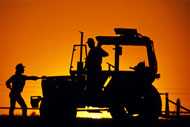AGRICULTURAL SAFETY

Occupational Injury Surveillance of Production Agriculture (OISPA) Survey
Frequently Asked Questions
About OISPA
What is OISPA?
OISPA is an acronym for the Occupational Injury Surveillance of Production Agriculture survey. OISPA data are collected for NIOSH by the U.S. Department of Agriculture, National Agricultural Statistics Service.
What data are available from OISPA?
Users can get estimates for the number of working adults on farms in the U.S. and estimates for the number of occupational injuries to adults that occurred on these farms.
How is an occupational injury defined?
An occupational injury is any traumatic event that resulted in at least four hours of restricted activity or requiring professional medical attention, and occurred while performing activities that had a direct impact on the farming operation as a business, regardless of whether the activity was performed for pay.
Where does OISPA get its data?
The data were collected through an interagency agreement between NIOSH and the U.S. Department of Agriculture, National Agricultural Statistics Service. The survey was conducted by telephone interview.
How was the survey designed?
The OISPA was conducted in conjunction with the Childhood Agricultural Injury Survey (CAIS). Using the Census of Agriculture as a sampling frame, a stratified (by geographic region) random sample of 50,000 farm households nationwide was selected for inclusion in the CAIS. A stratified random subsample of 25,000 farms was selected for the OISPA.
How are demographic and injury estimates generated?
Sampling weights for OISPA were calculated based on the total number of farms responding by geographical region and the number of farms reported by NASS in the appropriate year for each region. The nine geographical regions used are those defined by the U.S. Bureau of the Census. Weights were then adjusted based on three farm value of sales categories (< $10,000, $10,000 – $99,999, > $99,999). All estimates for both the injury and demographic data were obtained using the SAS Surveymeans procedure for a stratified equal probability sample.
What are the survey limitations?
There are several limitations to the estimates derived from OISPA. First, the recall period for an injury was up to 15 months. While the definition of injury excluded minor injuries, which may be easily forgotten, there is still the possibility that a reportable injury was not remembered by a respondent. A second limitation is that most of the respondents were the female head of household, which may have resulted in an under reporting of hired worker injuries, especially for larger farming operations with many employees. Third, there was no way to verify the accuracy or completeness of the responses, which could impart some measurement error into the overall results. Fourth, the survey did not capture injuries that occurred to contract farm workers. A final limitation is the possibility of a non-response bias. Due to the survey design, it was not possible to make a second contact to farm operators who refused to participate in the survey. This did not allow for a followback questionnaire to assess these refusals.
Can I compare estimates from OISPA to other public health data?
Caution should be used in comparing the estimates from OISPA to those reported from other public health data sets. A careful review of the definitions, methods, and limitations of these data should be made before making comparisons to other published reports or studies.
Are there privacy restrictions on OISPA data?
Yes. OISPA data can be used for aggregate statistical reporting and analysis only. The data available through OISPA are for public use and do not include information that would allow for the identification of an individual or a farm.
These data are covered under United States Code, Title 18, Sections 1902 and 1905; and Title 7, Section 2276.
OISPA users should:
- Use the OISPA data for aggregate or summary statistical reporting and analysis only.
- Not link OISPA results with individually identifiable data from other NIOSH or non-NIOSH data files.
- Make no use of the identity of any farm operation or individual discovered inadvertently and advise the Director, NIOSH, of any such discovery (800-35-NIOSH).
By using these data, you signify your agreement to comply with the above-stated statutorily based requirements.
What is the suggested citation for data from the OISPA tables?
When citing data obtained from OISPA, each citation should include the data source, the web address, and the date of access. The suggested citation is:
National Institute for Occupational Safety and Health (NIOSH). Occupational Injury Surveillance of Production Agriculture (OISPA) surveys public-use data, 2001, 2004, 2009, 2012, 2014. December 2016. Accessed at https://www.cdc.gov/niosh/topics/aginjury/OISPA/ on [date of access].
- Page last reviewed: April 11, 2017
- Page last updated: December 12, 2016
- Content source:
- National Institute for Occupational Safety and Health Division of Safety Research


 ShareCompartir
ShareCompartir